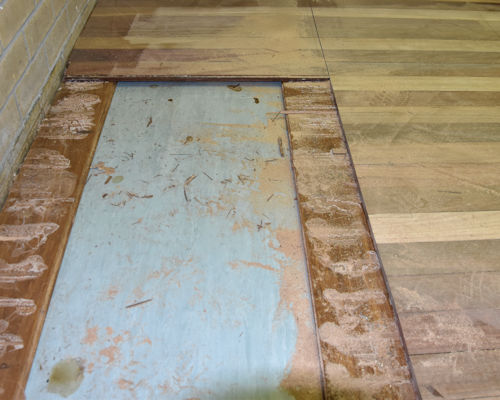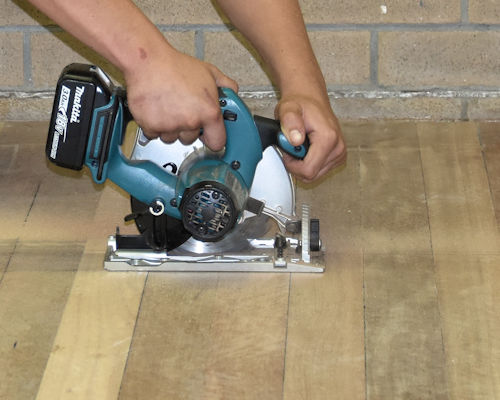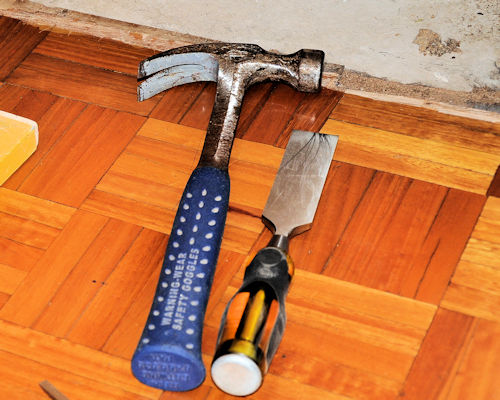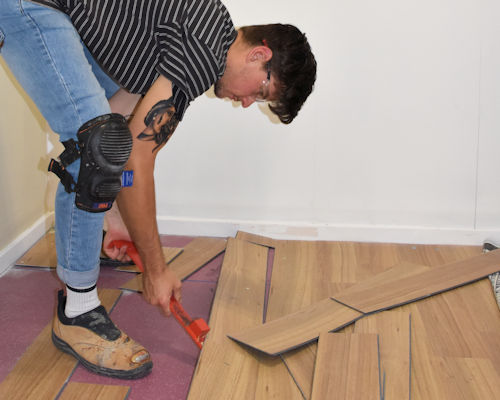Removing timber covering
 Audio for slide 1 (mp3 |6|KB)
Audio for slide 1 (mp3 |6|KB)
Timber floor coverings include all timber and wood-based coverings that are laid over the top of a structural subfloor.
The most common examples are:
- tongue and grooved floor boards (also called strip flooring), laid on battens or an underlay board product fixed to a structural subfloor
- direct-stick parquetry and strip flooring overlay, which are glued directly to a concrete slab or wood-based subfloor
- engineered timber flooring products (such as laminated timber on a wood-based backing), fixed to an underlay or laid without fixings as a 'floating floor' over a structural subfloor.

 Audio for slide 2 (mp3 |6|KB)
Audio for slide 2 (mp3 |6|KB)
Note that none of these examples perform a structural function - unlike the following types of timber or wood-based flooring, which can't be removed without taking into account the role they play in the building's structure:
- solid T&G floor boards that span across joists
- wood-based T&G sheet products, such as plywood or particleboard flooring, that span across joists.
Below are the main procedures used to remove different types of timber floor coverings.

 Audio for slide 3 (mp3 |6|KB)
Audio for slide 3 (mp3 |6|KB)
T&G floor boards on battens
The easiest way to take up strip flooring on battens is to put saw cuts across the boards, in between the battens, so that the boards can be pulled up in shorter lengths.
Lever the boards up using a pry bar or claw hammer.
If the boards are difficult to lift, use a lever with a longer handle, such as a floor scraper.

 Audio for slide 4 (mp3 |6|KB)
Audio for slide 4 (mp3 |6|KB)
Direct stick timber flooring
Timber flooring that is glued directly to the structural subfloor needs to be removed with a chiselling action.
Small areas can be lifted with a hammer and old chisel. Don't use your good wood-working chisels, since the cutting edge will be quickly damaged by the concrete and hard adhesive.
Larger areas will require a jackhammer, chisel scraper or floor scraper. If the timber covering is long-length T&G overlay boards, cut across them first with a circular saw.
Make sure the depth setting on the blade is fractionally less than the thickness of the board, to avoid cutting into the subfloor.

 Audio for slide 5 (mp3 |6|KB)
Audio for slide 5 (mp3 |6|KB)
Floating floors
Engineered boards that are installed as floating floors should be easy to remove, since they're not fixed to the subfloor in any way.
If the client wants to re-use the boards elsewhere, you should try to unclip them gently and stack them neatly, to avoid damaging the surface or breaking the tongues and grooves.
However, if they're going to be disposed of, you can work across the floor with a pry bar or other type of lever.


Learning activity
Audio 6 (mp3 |6|KB)Let's say you were pulling up an old timber floor covering and you noticed that there was fungal decay in some of the boards, or that mould was growing underneath the boards.
What alarm bells would that ring for you?
In particular, what sorts of checks would you make to try to track down the source of the problem, and what types of questions could you ask the client to get a better understanding of the issues?





